Marcasites.com™ is the publisher and leading authority site for marcasites or marquisites at wholesale prices.
Marcasites means marquisites and this term means pieces of pyrites, usually set in silver. Find treasures when you shop Marcasites.com™ or call us with questions. Known throughout the ages by a variety of names, these charming little beauties are not always what they seem to be, but one thing is crystal clear. Although these delightful little flirts love to dance in the limelight, marquisites are more than just another pretty plaything. In fact, they’re a smart buy, and here’s why.
Marquisites are mysterious and intriguing. They fascinate admirers the world over. When they compete, they can outshine any other beauty, whether by the light of day or by night. They stand out among their many competitors. They stand head and shoulders above the rest of the competition, not just for their sheer beauty, but because they are the smart alternative to diamonds. That makes them brilliant!
Marcasites.com™ is the leading source for obtaining marcasites or marquisites at wholesale prices. Over the centuries much has been written about these charming little darlings. Today, we realize that marcasites or marquisites as they are sometimes called are actually made from the mineral pyrite and not from the mineral marcasite.
Regardless of the many names that they collected throughout their history, their ability to capture our attention will never change. In fact, their mysterious and illustrious past only adds to their present-day intrigue. Surely, they will continue to fascinate and inspire us for many years to come. Here is a picture of a contemporary piece which exemplifies a popular design today.
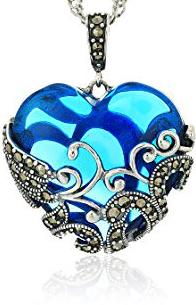
The piece shown above consists of small marcasites hand set and wrapped around a blue heart pendant in a sterling silver prong setting to which is added even more dainty marcasites set by hand around the pendant’s bale, all the while being suspended from a fine sterling silver chain. Shop and find other pieces similar to the one displayed above, or shop to find loose stones. Start by browsing the jewelry stores in our links section, and then return here to call us for our wholesale prices. Shop and call. It’s that simple. When you call make sure to request your coupon, or ask for special pricing before completing your purchase from any of the fine jewelry stores listed throughout our pages. We are waiting for your call, because we are ready to guide you during your treasure hunt.
Marcasites are Pyrites
Marcasites are jewels consisting in their simplest form of a mineral set in a silver setting. This mineral, from which the jewel takes its name, was believed to be marcasite, but this is a misnomer. The actual mineral, although similar in character, is actually pyrite, which is closer in texture, and is capable of receiving a more brilliant polish. Pyrite is found in several forms. In the crystallized state it is found in natural facets. Marcasites are made from pyrite.
Marcasites are made using cut and polished pieces of pyrite. They can also be faceted by hand for jewelry. It is clear, therefore, that although they are called marcasites, they are not made from marcasite at all. We shall now see that in another way, marquisites pretended to be what they are not.
Marcasites pretended to be diamonds, and so successfully that they were very largely worn in the eighteenth century, and then, as now, it was very difficult in artificial light to distinguish marcasites from diamonds.
Marcasites are Collectible
Marquisites as they are sometimes called amused us for centuries, but very little appears to be in print regarding them. Marquisites are believed by many to have been known in Elizabethan times. Although the mineral itself was known and used even in earlier times, its production in the form of marcasites was not earlier than the middle of the eighteenth century. Marcasites first appeared during the reign of Louis XV, during which the most characteristic trait was the perfection of daintiness. For that reason, marquisites have become increasingly sought after and because they are so collectible they are becoming increasingly valuable. They are admired the world over and by every class, because they never fail to impress. Simply put, they can satisfy the most critical taste.
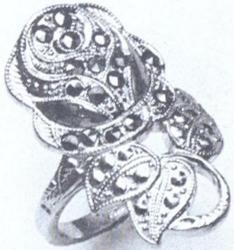
Marcasites and Origin
Marcasites and their origin continue to fascinate both jewelers and historians, because pyrite is also found in forms other than the crystallized state. A second form is found in flat surfaces in the fissures of rocks, where the action of the forces of nature, such as pressure and friction, has polished the surface until objects are reflected in it.
Marcasites find their origin in pyrite, not in the mineral marcasite. That is a fact. We made that much sufficiently clear. Now that we put an end to the myth or at least put the fallacy to bed, let’s dig deeper into their past.
Let’s look further into their rocky history. We can see the path, by tracing it and then following their footprints from their origin in rocks to the boudoir was a very short step, for we find that the Roman ladies used pyrite for their mirrors, and in doing so, they probably saw themselves reflected in a much better light than that shed upon them by the historian who described them in later times.
Even later in yet another hemisphere, we find that pyrite which is the source of marcasites or the “stone,” as I must call it, was known to the Incas, the ancient inhabitants of Peru, and was used by them as amulets; hence it is also called “pierres des Incas.” Whether those exquisite workers in gold used it in any other form is not known. It is also spoken of as “pierre de santé,” and was believed to change color according to the health of the wearer.
We also have the authority of Boileau for stating that it was used in conjunction with steel for producing fire. In fact, he refers to its use for this purpose in his well-known mock heroic poem, “Le Lutrin,” published in 1682.
Marcasites in Vintage Jewelry
The first mention that I can find of marcasites and their use in jewelry is in the twenty-seventh volume of a modest work by M. de Félice, who, happily, had taken all knowledge to be his province. This work, published in 1773, is called “Encyclopédie Dictionnaire des Connaissances Humaines.”
It appears that, in the year 1750, when one Etienne de Silhouette was Controller of Finances to Louis XV, things in France were in a bad way, and the Treasury was found to be empty. The Minister, at his wit’s end to supply the needs of “Le Bien Aimé,” hit upon the ingenious and indeed ingenuous idea of appealing to the patriotism of the ladies of France. The events that would unfold might account for the later introduction of marcasites, because he implored the ladies to send in their jewelry and trinkets to fill the depleted Treasury, and so save their country. Now patriotism and luxury as you might expect, do not always flourish side by side, and the fair ladies who thronged the “Œil de Bœuf” did not care a dump for their country. We are not therefore surprised to hear that they greeted the Minister’s appeal with derisive laughter, and indeed perpetuated his attempts at economy and thriftiness by naming after him the cheap black paper snippets, which we now know were the precursors of the daguerreotype and photograph.
It has been stated, albeit on somewhat doubtful authority, that marcasites were made to supply the deficiency of jewels caused by this appeal, but we have already seen there was no deficiency at all; and so a better and, to my mind, much more reasonable explanation is at hand to account for its introduction.
We read that about this period the “bourgeoisie,” the merchants and traders, had greatly increased in consequence and wealth, and it seems probable that marcasites were produced to meet the growing demand for articles of adornment worn by ladies who were “not of the court,” and for whom the cost of real jewels was prohibitive. Anyway, whatever the cause, marcasites became immediately popular. Their extraordinary brilliance, their superiority in their respect to paste, and their effective simulation of diamonds no doubt, ensured their wide use. In fact, we also know that in Switzerland, when the wearing of diamonds was forbidden, marcasites were largely worn.
Why marcasites are sometimes known as “marquisites” is difficult to conjecture. I like to think they took their name from the dainty ladies of the French Court who wore them. A necklace now included as part of a collection which has remained in my family’s possession for more than a century and which has the double SS chain to which is attached a pendant surmounted by the crown of France, provides ample proof that marcasites were by no means confined to the bourgeoisie!
Marcasites are also referred to among the treasures belonging to Madame du Barry in Edmond de Goncourt’s “The Confidantes of a King.” And then it is also spoken of — albeit somewhat disparagingly — by Mrs. Hardcastle in Oliver Goldsmith’s delightful comedy “She Stoops to Conquer,” which was published in 1773.
Marcasites are Adornments
So much we know of marquisites and their history; let us now enquire into their merits as an article of adornment. Marquisites, as I have already described, were set like any other jewel in silver, having previously been faceted by hand, after the manner of a rose diamond. Some marquisites were enriched by the addition of enameled miniatures, others with different colored stones or carbuncles “en cabochon,” others again with various colored enamels, among which are found some of a beautiful blue color undistinguishable from turquoise. One variety is found in combination with a substance known as “coq de perle,” which has a fine skin, a faint pinkish color, and resembles pearls. I have been unable to gain any knowledge or find any reference to this “coq de perle,” which does not appear to be a composition, but rather a natural product, a kind of pseudo pearl; possibly, like the true one, formed in the oyster itself.
Other marquisites are set over foiled and colored glass, red, green or blue, producing a rich effect.
The pre-eminent quality however of marcasites, apart from their brilliance, is the beauty of their design, which is not surpassed by any other class of jewelry. The illustrations found on Marcasites.com will to some extent enable the reader to judge for himself. As a rule the most valued pieces are where the “stone” is smallest. Therefore, take note!
Small marcasites set by hand in silver prong settings make the most exquisite pieces. Here is a close up view of such dainty handiwork taken from a silver brooch.
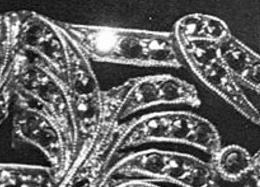
Close up view of the small marcasites set by hand in a silver prong setting.
Marcasites in Revivals
It is probable that the taste for marcasites lasted throughout the reign of Louis XVI down to the Revolution; but, in addition to the original invention in 1750, there have been two revivals, one in the year 1849, the other within the last few years.
The latest revival can be dismissed very summarily, both the stones and the setting being thinner, and the stones themselves not so deeply set. Also a garishness, a whiter appearance, owing to the newness of the setting, and a roughness to the touch dispose of its claims to superior rank in the art.
Thus, we are left with marcasites from the Louis XV period and the period of 1849 for further discrimination. For making the cavity in which the “stone” rests in a piece of the Louis XV period, no drill was ever used and consequently when a “stone” falls out, no drill point reveals itself.
The tests by which marcasites from the period of 1849 is to be tried offer more difficulty in the application. Touch and appearance do not help us here, because constant cleaning has smoothed the rough points in the setting, and age has done away with the whiter appearance observable in quite modern marquisites. The only test that remains is, therefore, the mark of the drill, which in the marcasites of 1849 and later, when they are complete, is concealed by the “stone.” But I am inclined to think that on the removal of a “stone” in any such marquisites the point marking the place where the drill had been would reveal itself. In the marcasites of 1849 and after, we find, instead of “coq de perle,” mother of pearl, and the beautiful turquoise enamel is replaced by an inferior colored china.
Marcasites appear also to have been made in Switzerland, and possibly in Spain. But the setting in these foreign pieces is clumsier and of inferior workmanship to the French. In some cases, it is made of wire-work and is easily broken.
There is no difficulty in distinguishing marcasites from old cut steel, although it may deceive the unwary. The former, we have seen, is set like any other gem, while in the latter, each piece is separately riveted on to the setting, which can be easily seen when the object is reversed. There is, indeed, a final test — the use of a magnet — which has no power to attract marcasites.
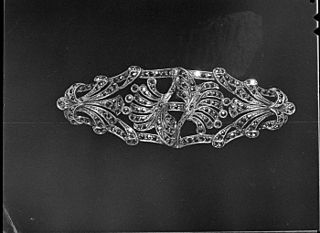
Marcasites set in Silver Brooch.
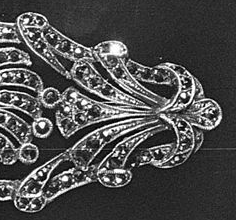
Marcasites set in a silver setting on the left side of a silver brooch.
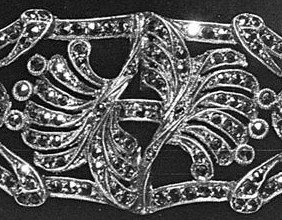
Marcasites set in a silver setting in the middle of a silver brooch.
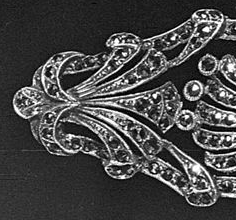
Marcasites set in a silver setting on the right side of a silver brooch.
The illustrations of marcasites which accompany this article show the unique designs of the various pieces, but can not necessarily convey either their brilliance or their color.
Marcasites Sparkle Like Diamonds
The use of pyrites among the Romans is not a mere matter of conjecture. Heraclius, in his all but unintelligible doggerel, “De Artibus Romanorum,” written in the 7th century, actually speaks of engraving upon glass with “the hard stone known by the name of pyrites.”
Fossil shells, especially echini and small ammonites, are plentiful, composed entirely of iron pyrites, forming beautiful golden objects which must have often excited the admiration of the ancient miners.
From their use to the lapidary, marcasites were an important article with the Persians. Ben Mansur devotes a separate chapter to them, dividing the kinds, according to their color into gold, silver, iron, and copper marcasites.
Marcasites, when faceted, have a true adamantine luster (though perfectly opaque), which they preserve without tarnishing. But more importantly, we find that in the last century, they were much used in jewelry as a very attractive and affordable substitute for diamonds. Again, take note.
Marcasites in Pawnshops
Connoisseurs of marcasites or just about any shopper with a trained eye will find that fine specimens of good design are becoming an exceedingly rare find. I can only surmise that most of the best pieces with the best stones have already found their way from the attics of our grandparents into the collector’s box. Sometimes these precious pieces can be unwittingly discarded by naïve grandchildren or any heirs without a trained eye.
If one man’s trash is another man’s treasure, then let your treasure hunt start online. Start digging through the showcases of vendors and pawnshops online. If you visit the best vendors you can find marcasites and all kinds of affordable treasures! The sky is your limit. We’re waiting.
Marcasites create a magnificent display of dancing lights that can grace any stage. Thanks to their sheer brilliance, these elegant treasures will always captivate our attention. You can see their beauty and charm come alive through the display cases. They will gracefully stand out among any other jewel. In fact, marquisites love upstaging all the other stones and showing off so much, you shall have absolutely no trouble at all, finding marcasites dancing in the limelight of pawnshops!
Copyright © 2021. Marcasites.com™. All rights reserved.
